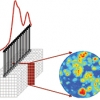Articles
Near infrared spectroscopy: the practical chemical imaging solution
Chemical imaging spectroscopy is an exciting new analytical advance that answers commonly asked questions such as what chemical species are in a sample, how much of each is present, and most importantly, where are they located? Through the fusion of traditional infrared spectroscopy with powerful microscopic and macroscopic imaging capabilities, chemical imaging spectroscopy answers all these questions simultaneously, in a single rapid measurement.
Sorting the wheat from the chaff
Tony M.C. Davies
Norwich Near Infrared Consultancy, 75 Intwood Road, Cringleford, Norwich NR4 6AA,UK
Tom Fearn
Department of Statistical Science, University College London, Gower Street, London
Wavelength selection and probe design for the customisation of micro-spectrometers
A.N.Davies, H.M. Heise, P. Lampen, R.H. Kurte and L. Küpper
ISAS, Institute of Spectrochemistry and Applied Spectroscopy, Bunsen-Kirchhoff-Str. 11, Postfach 10 13 52, 44013 Dortmund, Germany
Uncertainty testing in PLS regression
A.M.C. Davies
Norwich Near Infrared Consultancy, 75 Intwood Road, Cringleford, Norwich, NR4 6AA, UK
Changing scales with Fourier transformation [Lesson 3 of matrix algebra (matrix multiplication)]
In the last column, we showed how we could perform Fourier transformation (FT) of a near-infrared (NIR) spectrum in a few lines of matrix algebra and said that in this column we would use it in a novel way. The task we are going to perform is that of changing scales of spectroscopic (NIR) data. This may be novel, we are not aware that anyone else does it this way, but of course instrument manufacturers sometimes like to be silent about the methods they employ.
The TDeious way of doing Fourier transformation (Lesson 2 of matrix algebra)
At the end of the last column we promised that this time we would show how matrix algebra can be used for real computational tasks. The chosen task is Fourier transformation (FT) of a near infrared (NIR) spectrum. Those who know Tony Davies will not be surprised at this choice of subject but in the third lesson the reason for wanting to do the obvious will become apparent.

